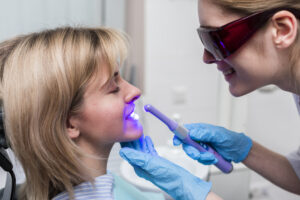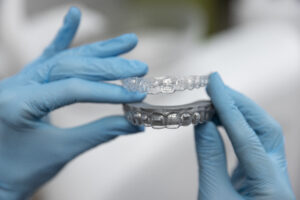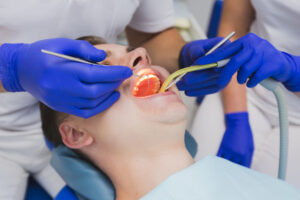Understanding Dental Anxiety and Phobia
What Is Dental Anxiety — And How Is Phobia Different?
Dental anxiety refers to worry or nervousness about dental care—like what might happen during a check‑up. Dental phobia, on the other hand, is an intense, persistent fear that causes people to avoid seeking treatment even when it is urgently needed. The official mental health manuals view severe dental phobia as a type of specific phobia: persistent, uncontrollable, and out of proportion to actual risk.
How Common Is This Problem In The United States?
Up to 36 percent of adults report moderate anxiety about dental work, and about 12 percent meet criteria for extreme fear or phobia. A US survey by the American Dental Association found nearly 30 percent felt “somewhat nervous” or worse before a dental appointment; around 5 percent describe their fear as “terrified,” and many cancel appointments as a result. This anxiety leads to delayed care, emergency treatments, and worsening oral health over time.
Causes of Dental Anxiety and Phobia
Past Dental Trauma And Pain
Experiencing a painful or upsetting dental visit—especially in childhood—can trigger fear that sticks even after years. Lesser pain control during care is strongly linked to later avoidance and fear.
Fear Of Pain, Needles, And Loss Of Control
Many people fear injections, sharp tools, or not being able to stop a procedure. Feeling out of control—especially when reclined in a dental chair—can raise anxiety before treatment even begins.
Learned Influences And Family Patterns
Some people develop dental anxiety after witnessing anxious parents or hearing experiences from others. Verbal warnings (“It will hurt!”), media portrayals, or recollections from friends, may reinforce that belief, even without direct personal experience.
Treatment Options — Managing Fear and Restoring Care
Psychological Techniques And Behaviour Work
Cognitive‑Behavioural Therapy (CBT)
CBT helps patients identify fears and gradually change them by learning coping strategies. This method has shown long‑term benefits in reducing dental avoidance and increasing visits.
Exposure And Desensitisation
In exposure treatments, patients begin by familiarising themselves with parts of the process, like the waiting room or the chair, before moving on to a full cleaning or procedure. Tell‑show‑do techniques—where staff explain, demonstrate, and then perform—help build tolerance in small steps.
Relaxation, Imagery, And Guided Breathing
Breathing exercises, progressive muscle relaxation, and imagining calming scenes can reduce tension before and during care. Studies support these strategies in easing mild to moderate anxiety.
Distraction And Comfort Items
Listening to music with headphones, holding a stress ball, or watching a video can redirect attention during procedures. Even something as simple as squeezing a handheld item on cue can ease nerves.
Sedation Methods — When Anxiety Is More Severe
Nitrous Oxide (Laughing Gas)
A mild inhaled sedative that induces calmness and allows patients to respond verbally and breathe on their own. It wears off quickly and has few side effects.
Oral Sedation
Taken as a pill about an hour before the appointment (common drugs include triazolam, diazepam). These reduce both anxiety and memory of the visit; they do not eliminate pain and need to be used with local anesthesia.
Intravenous (IV) Sedation And General Anaesthesia
IV sedation offers deeper relaxation, while general anaesthesia may be used only in hospital settings or in cases like developmental disability or severe panic disorder. Public data suggest that about 6 percent of anxious patients receive some form of sedation, with most procedures safely completed.
Advanced Approaches — Hypnosis And Virtual Reality
Hypnosis can support focus and reduce gag reflexes or tension for some. Virtual reality exposure therapy (VR) is increasingly studied and offers immersive distraction or gradual exposure in a controlled way—both methods show early promise in lowering phobia-related distress.
Breaking the Fear Cycle and Regaining Hope
One of the most harmful patterns is the “cycle of dental fear”: avoidance leads to problems that eventually cause emergencies, which reinforces fear. Recognizing the cycle is the first step towards breaking it.
By choosing to return for a simple exam or cleaning once, anxiety may begin to shrink. Small steps, firm but gradual exposure, and honest communication with the dentist can restore trust over time.
Progress Happens Slowly
It’s common to feel some tension in early visits. But as a person experiences pain‑free care and gains confidence, fear diminishes. Even a straightforward session with music and breaks can help build positive memories.
Setting Realistic Expectations
Realistic expectations—for example: “I may feel nervous at first, but I can ask for breaks”—help people stay in control. Many dentists will agree on a stop signal or short pause plan to give the patient autonomy.
Long‑term Gains
As anxiety decreases, patients are more likely to keep up with regular dental visits. This leads to better oral health, less need for invasive treatments, and a lower chance of painful emergencies. Improved dental health then supports better overall well-being and reduces fear in the future.
Small Steps, Big Change: Overcoming Dental Anxiety
Dental anxiety and phobia are real and common—but they don’t have to dictate your oral health journey. Understanding the causes, choosing effective treatments, and working with a caring dental team can shift fear into hope. Whether you begin with relaxation exercises, simple distraction, therapy, or safe sedation, each small step can build confidence. Over time, many people go from avoiding care to keeping a regular appointment schedule—and with that, a greater sense of control and wellness.




